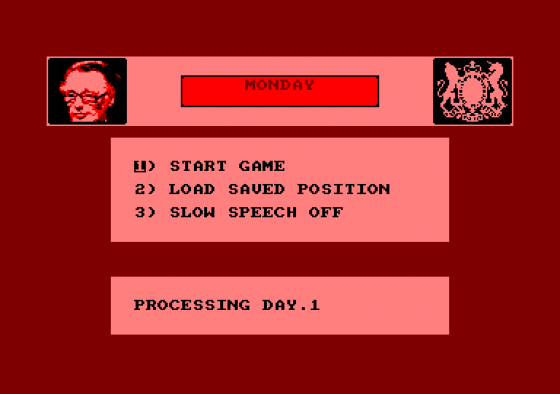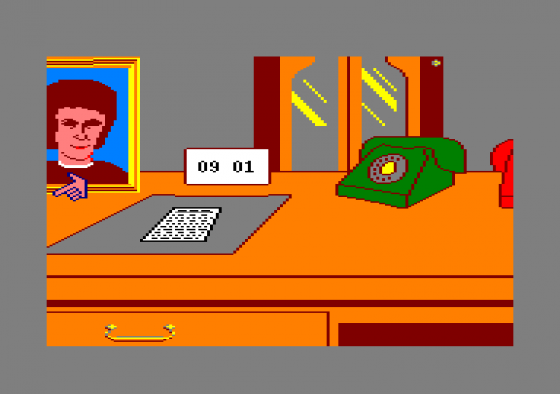
Amstrad Action
 1st December 1987
1st December 1987
Published in Amstrad Action #27
If someone builds a car out of matchsticks, and then gives it to you saying "Why don't you pop off for a drive?", do you think that (a) they're bonkers; (b) you're bonkers for listening to them; (c) they're not only bonkers, but also to be blamed for wasting your valuable time?
I only ask because I'm a bit at a loss as to what to say about this game. First and foremost, it's absolutely no good as an adventure, or even - I would say - as a computer game of any kind! On the other hand, like a car built out of matchsticks, it does have a certain charm. Once you've seen it, however, the charm, by failing to offer any real value, begins to disappear...
Yes Prime Minister is a multiple-choice game, rather like the Adrian Mole programs done by Level 9 (and also marketed by Mosaic). However, instead of choosing between different actions to alter the course of the plot, you choose between different points of view. These points of view, usually part of a humorous conversation between Prime Minister Jim Hacker and his cronies Sir Humphrey Appleby (Cabinet Secretary) and Bernard Woolley (Private Secretary to the PM) develop into policy statements that influence your ratings in the poll. The aim of the game is to get as a high a poll rating as possible.

Most people will already realise that the game is based on the TV program of the same name. Like the telly series, the scenario centres on dry wit and humour, concerning such issues as a Ministry for Women (bound to offend the male voters) or the indiscretions of a drunken colleague. In each case, you, as PM, must steer your way through a witty conversation on the subject, selecting at frequent junctures the replies and ripostes that will impress your cronies and, if necessary, lead to the "correct" solutions being applied to the various problems.
The Adrian Mole programs did all this simply by scrolling the text down the page and asking you at various points to choose between three options. Yes Prime Minister is much more ambitious - it shows you the interior of your office, complete with desk, two drawers, blotter, two telephones, teletype and intercom. There's also a safe (which holds your current poll rating) and a door to the outside world.
Not all of this is visible at once, so you use a pointer to scroll the screen and then after positioning it on an object, click the fire button to use that object. It's important to realise that you can't use an object at any time, but just when the program draws your attention to it by flashing it or beeping, or by some other signal. Thus, in Adrian Mole, the text would have read "You receive a phone call from the Cabinet Secretary, he says..." In Yes Prime Minister, the telephone flashes, you click on it, and a text screen prints out the ensuing conversation, complete with options.

The game takes place in five sections, or days, being one week in the life of a PM. Each day has its own appointments schedule, which requires you to attend various meetings. Thus you must juggle answering the phone and reading the occasional memo (delivered to your desk) with clicking on the door to leave your office and attend a conference with one of your colleagues.
Clicking on the door gives you a menu of destinations; Sir Humphrey's office for example. Should visiting one of these be appropriate at that time (indicated by the clock on your desk) then rather than see a display of the interior of that location you will simply get a text description of what takes place there - another debate with more options to choose from.
The problems with this game are two-fold. First, the game format (as with the Mole games) forces the player into a very passive role, limited to simply choosing between different points-of-view presented by the program. Secondly, however often you play the game there really isn't sufficient variety in the storylines to keep your interest. Naturally, this is all because of the design concept of the game, which is why I mentioned the matchsticks earlier. Frankly, it's not a concept that appeals to me one jot.
I don't deny that the text is often extremely witty and that the first hour's playing was most enjoyable. The second hour, however, saw a number of repetitions of the storyline. The third hour led to the machine being switched off. Mosaic point out that there are a number of "random scenarios" that will occur in a game, making each game different. What this actually means is that if you make about 30% of each game different, the other 70% will rapidly become depressingly familiar.
At the price, this sort of repetition, however whimsical the subject matter, is really not on. The usual adventure ratings are not really appropriate here but, for what it's worth, I've given some indication of the "feel" of the game, (atmosphere), its scope (challenge) and my personal estimation of its overall value.













